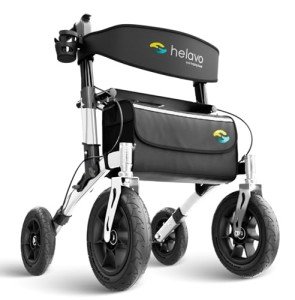Understanding Transport Walkers: A Comprehensive Guide
Transport walkers are crucial mobility help developed to improve the independence and security of people, especially the elderly and those with mobility obstacles. Integrating the performance of a walker with the benefit of a seat, these gadgets allow users to preserve their mobility while offering a resting option whenever necessary. In this article, we check out the features, advantages, types, and upkeep of transport walkers, together with regularly asked questions to equip readers with essential knowledge.
What is a Transport Walker?
Transport walkers are mobility devices geared up with wheels developed for people with mobility challenges. Unlike traditional walkers, which require users to raise them somewhat to move, transport walkers include wheels that facilitate rolling. Heavy-Duty Rollator Walker include a seat, handlebars for stability, and a storage basket for personal items.
Secret Features of Transport Walkers
- Wheeled Base: The rolling wheels enable easy movement, lowering the strain on the user.
- Foldable Design: Most transport walkers can be quickly folded for storage or transport.
- Comfortable Seating: A padded seat is usually incorporated, offering users a place to rest.
- Hand Brakes: Designed for security, most walkers include hand brakes that allow users to manage their speed and maintain stability.
- Storage Options: A built-in basket or pouch at the front allows users to bring individual items without the requirement for additional bags.
Benefits of Using Transport Walkers
Transport walkers use various benefits that deal with the requirements of various users:
1. Increased Mobility
Transport walkers allow people to navigate their areas more freely. They are particularly advantageous for those recuperating from surgical treatment or handling chronic health problems.
2. Security and Stability
With a durable frame and helpful handlebars, transport walkers offer stability, lessening the danger of falls and mishaps.
3. Resting Capability
The seating choice uses users a possibility to rest throughout extended outings, which is important for those who may tire quickly.
4. Easy Maneuverability
Transport walkers are lightweight and created for smooth motion, making them easy to use both inside your home and outdoors.
5. Independence
By utilizing transport walkers, individuals can take part in activities without relying greatly on caretakers, therefore boosting their independence and lifestyle.
Kinds Of Transport Walkers
When thinking about a transport walker, it's crucial to acknowledge the various types readily available:
| Type | Description |
|---|---|
| Standard Transport Walker | Basic design with four wheels and a seat. |
| Transport Wheelchair | Combines the functions of a walker and a wheelchair. Can be pushed by a caregiver. |
| Heavy-Duty Transport Walker | Designed for bigger users, supplying extra stability and weight capability. |
| Two-Wheel Walker | Features two wheels at the front and two back legs, allowing for better balance. |
| Reclining Walker | Offers adjustable seating for convenience, targeting users with special needs. |
How to Choose the Right Transport Walker
Elements to Consider:
- User's Height: Ensure that the walker is adjustable to the user's height for optimal comfort and safety.
- Weight Capacity: Check the walker's weight limit to ensure it can accommodate the user.
- Intended Use: Determine if the walker will be used mostly inside your home, outdoors, or both.
- Storage Features: Evaluate the benefit of storage alternatives offered with the walker.
- Portability: If regular transport of the walker is essential, consider its weight and how easily it can be folded.
Maintenance Tips for Transport Walkers
To prolong the life and effectiveness of a transport walker, follow these upkeep pointers:
- Regular Cleaning: Wipe down the frame and seat with a moist fabric to remove dirt and stains.
- Examine the Wheels: Ensure the wheels are rolling efficiently; lube if needed.
- Examine Brakes: Regularly check that hand brakes work correctly for added safety.
- Tighten Up Bolts and Screws: Periodically inspect and tighten up any loose parts.
- Replace Parts As Needed: If wheels or footrests show indications of wear, consider replacing them for optimum security.
Regularly Asked Questions (FAQs)
1. Who can take advantage of a transport walker?
Transport walkers are ideal for older adults, individuals recuperating from surgical treatments, and those with conditions such as arthritis, stroke, or balance issues.
2. Are transport walkers ideal for outdoor use?
Yes, lots of transport walkers are created with durable products and wheels that can handle outdoor surface, although it's best to inspect manufacturer specifications.
3. How much weight can a transport walker generally manage?
The majority of transport walkers have weight capacities varying from 250 to 400 pounds, depending on the brand and model.
4. Do I need a prescription to acquire a transport walker?
While a prescription is not normally needed to buy a transport walker, seeking advice from a doctor can help in picking the best walker for particular needs.
5. Can transport walkers be utilized by individuals with minimal upper body strength?
Yes, lots of designs are developed with features that supply stability and make them much easier to utilize for individuals with restricted upper body strength.
Transport walkers are invaluable help that promote independence, safety, and mobility for people with mobility obstacles. By understanding their features, advantages, and maintenance, users can choose the best walker to suit their way of life. Purchasing a transport walker can make a substantial difference in boosting one's quality of life, making day-to-day activities more workable. Whether utilized for brief errands or longer adventures, a transport walker provides the support and confidence required to navigate the world.

